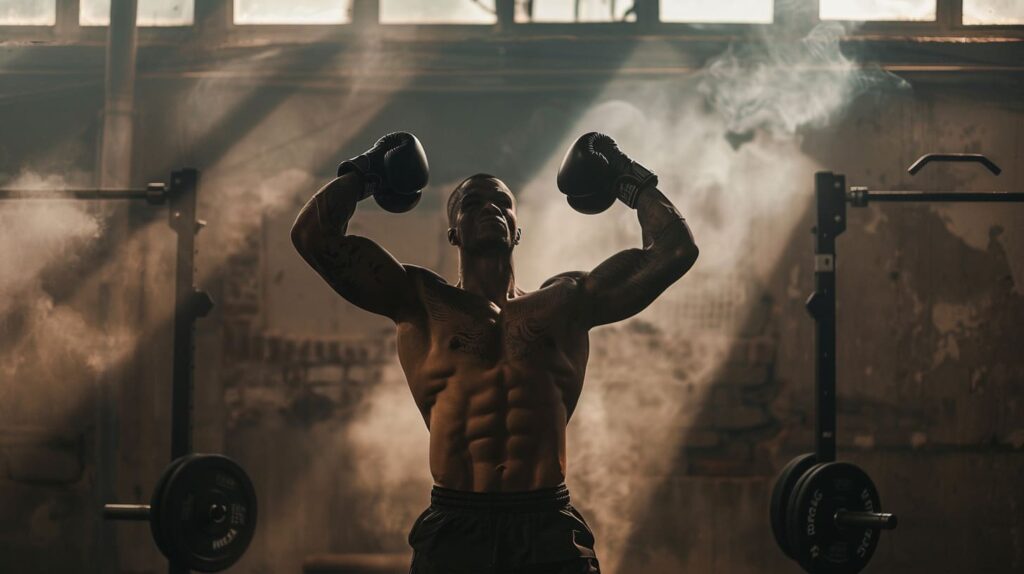There’s a magnetic appeal to the classic boxing knockout punch – it’s the crescendo in a symphony of skill, strength, and sweat. Getting that knockout punch right is not just about throwing your weight around; it’s about a cocktail of technique, peak fitness, and the kind of finesse that turns fighters into legends. Let’s dive in to understand what really packs a wallop in the ring.
Mechanics of a Powerful Punch
A mighty punch in boxing isn’t just a show of brute force; it’s more akin to a well-executed dance move. Think about it – to throw a punch that truly delivers, you have to start from the ground up. Pivoting the rear foot is your first move. This seemingly simple twist is like turning the key in the ignition of your punching power.
Why is pivoting so crucial? Well, as it turns out, it’s all about leverage and power. The rear foot acts as an anchor, allowing you to build rotational speed as your body turns into the punch. The pivot transforms energy from your foot, through your leg, and across your core, culminating in a fist that can strike with the force of a wrecking ball.
Here’s a snapshot of the key ingredients:
- Footwork: Essential for balance and power transfer.
- Hip Rotation: Paves the way for core muscles to add oomph to your punch.
- Shoulder Alignment: Together with hips, shoulders amp up rotational force.
- Arm Extension: The final act of the power play, extending through the punch.
Proper boxing form isn’t just about looking good in the ring. It’s about aligning each part of your body to channel force most effectively. That means hand positioning isn’t arbitrary; every twist of the hip and extension of the arm should be deliberate, like the gears of a well-oiled machine. Such precision ensures that not a joule of energy goes to waste.

So, what does perfect form look like? Imagine your body is a coiled spring, storing up potential energy. When you punch, that spring releases all at once, driving force straight through to your target. Achieving this doesn’t happen overnight. It’s like learning a new language – start with the basics and practice until it’s second nature. The rewards for patience and practice in perfecting your form are as satisfying as the thud of a glove on a heavy bag.
Strength and Speed in Power Punching
Building up a punch that packs a powerful impact is not just about how hard you can hit, but also how fast and strong you are when you do it. Like a bullet, a punch’s force is a combination of speed and mass; and in boxing, that speed and strength come from shoulders, arms, and core muscles. The swiftness of your hook or your cross doesn’t just come from your arm – it’s the result of your entire body working in sync.
Explosive strength is what you need to focus on if you want to increase the power behind your punch. This is about quick, forceful movements – power that comes in a flash. Think of plyometric exercises like pushups that throw you off the ground; these not only build upper body strength but also train your muscles to contract more quickly and powerfully. With plyometric pushups, you’re not just pushing up; you’re launching with force. This explosive energy is mirrored in a punch, translating into a knock-out potential.
Now, let’s talk about some exercises that will help you put more boom into your punch:
- Plyometric Pushups: Not your average pushup; these engage fast-twitch muscle fibers for explosive power.
- Heavy Bag Drills: Working with a bag that fights back, building both strength and endurance.
- Medicine Ball Throws: Excellent for developing core explosion vital for transferring power through your punches.
- Speed Work: Exercises like shadow boxing with light weights increase speed, leading to harder punches.
Clearly, it’s not just the number of reps but the quality of each movement that transforms a good boxer into a powerhouse in the ring. Next time you’re in the gym, integrate these exercises into your routine and notice how they add a knock-out note to your punches.
Timing and Accuracy

To connect effectively, you need to be a master of timing. This means reading the rhythm of the fight and delivering your punch right when your opponent least expects it. It also means precision in aiming for those sweet spots where it will have the most significant impact.
Consider the key elements that sharpen timing and accuracy:
- Rhythm Recognition: Understanding the flow of the fight to anticipate opportunities.
- Focus Mitt Training: Working with a trainer on the mitts hones your ability to hit specific targets consistently.
- Shadow Boxing: Refining technique and improving muscle memory without the risk of injury.
- Sparring: Real-world practice that teaches you to find openings and land punches when it counts.
When you marry the raw power of your punch with the scalpel-like precision of timing and accuracy, you’ve got a recipe for the kind of striking that not only looks impressive but more importantly, one that lands effectively and wins matches. It’s not just brute strength – it’s intelligent, precision power punching.
Genetics and Muscle Fiber

Every boxer steps into the ring with their own biological deck of cards. Genetics can hand you an ace in the form of naturally powerful punch potential. Some are born with the kind of bone structure and muscle composition that seem tailor-made for delivering thunderous blows. Fast-twitch muscle fibers, the type that contract quickly and provide explosive power, are particularly plentiful in certain individuals, and this can make a noticeable difference in their punch force.
But let’s get one thing straight: relying on genetics alone to carry you to victory is like stepping into the ring with one hand tied behind your back. The key lies in honing these natural gifts with diligent training. Here’s a reality check – even those with genetic advantages need to nurture their craft to excel.
- Bone Structure: A heavyweight factor in the force of your punches.
- Muscle Composition: More fast-twitch fibers can mean more natural explosive power.
- Training Impact: Regardless of genetics, technique, and conditioning crucially amplify punching power.
It’s a potent combination of natural prowess and relentless refining of skills that underlines the power in power punching. Whether you’re genetically predisposed to pack a punch or not, there’s no substitute for the sweat and grit of training.
Integrating Power Punching into Your Boxing Strategy

Integrating power punches into your boxing strategy is like adding a secret weapon to your arsenal. However, the trick is in knowing when and how to use it. Power punches shouldn’t be your only strategy; they’re a part of the symphony – a dramatic crescendo rather than the entire composition.
A balanced approach means varying your tactics, keeping your opponent guessing, and conserving energy for the perfect striking moment. Look at any seasoned boxer; notice how they weave power punches seamlessly into combinations, creating opportunities rather than waiting for them.
Here are strategic tips for packing a punch:
- Variety is Key: Mix up your shots to keep opponents off-balance.
- Energy Management: Save your big punches for moments when they’re most likely to land.
- Opponent Analysis: Tailor your strategy to exploit your opponent’s weaknesses.
Don’t just fall in love with the raw thrill of power – boxing is a cerebral sport as much as a physical one. Mastering the ebb and flow of dynamics, rhythm, and strategic power punching is what separates the contenders from the champions. It’s a delicate dance of force and cunning, and knowing the moves is how you win the bout.
Conclusion
To sum it up, the journey to achieving that crowd-roaring, opponent-dropping power punch is multifaceted. It’s not just about the adrenaline-infused crescendo of strength; it’s also a ballet of mechanics, technique, and strategy finely tuned over countless hours of practice. We’ve explored the importance of perfecting the pivot, building explosive strength and speed, and the art of landing a punch with pinpoint accuracy. In the background, genetics strum a baseline that may influence the tune but doesn’t dominate the melody of a fighter’s potential.
From the swell of muscles finely tuned by drills to the conductor’s baton of strategic intellect, it’s the blend of science and art that delivers a knockout performance. Let’s step out of the corner, ready to dance around the ring, armed with the knowledge that even the most powerful punch is part of a larger choreography—one that champions the heart-pounding thrill of classic boxing.

